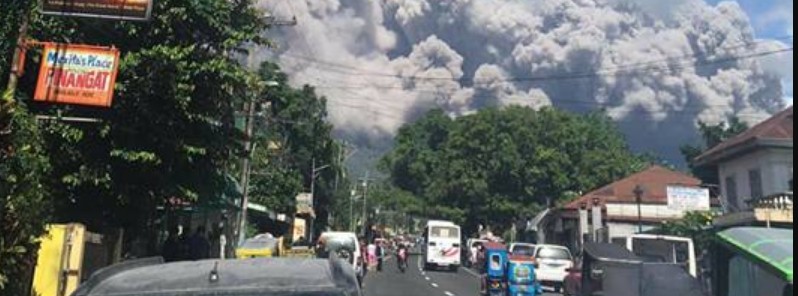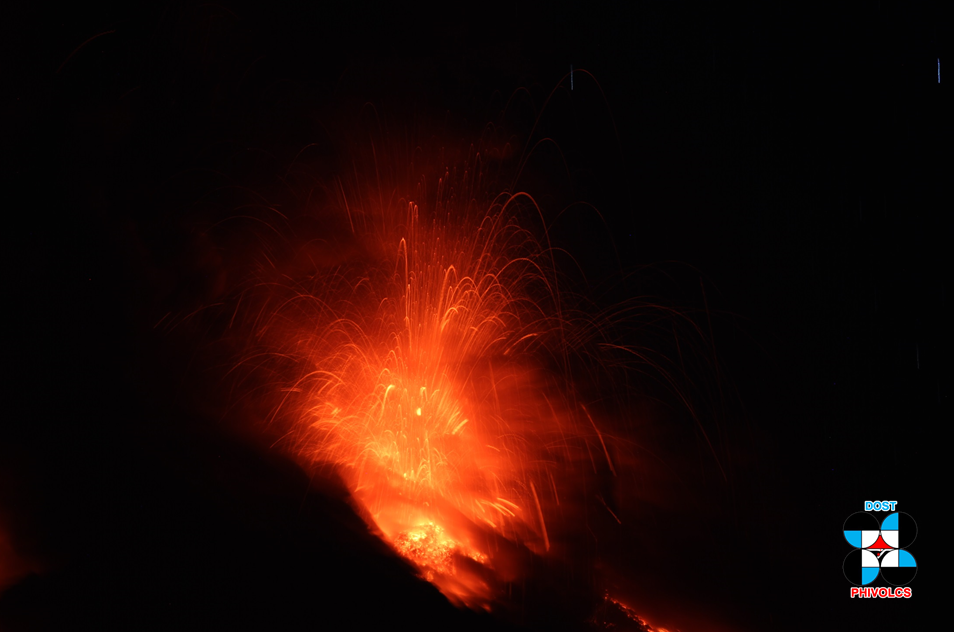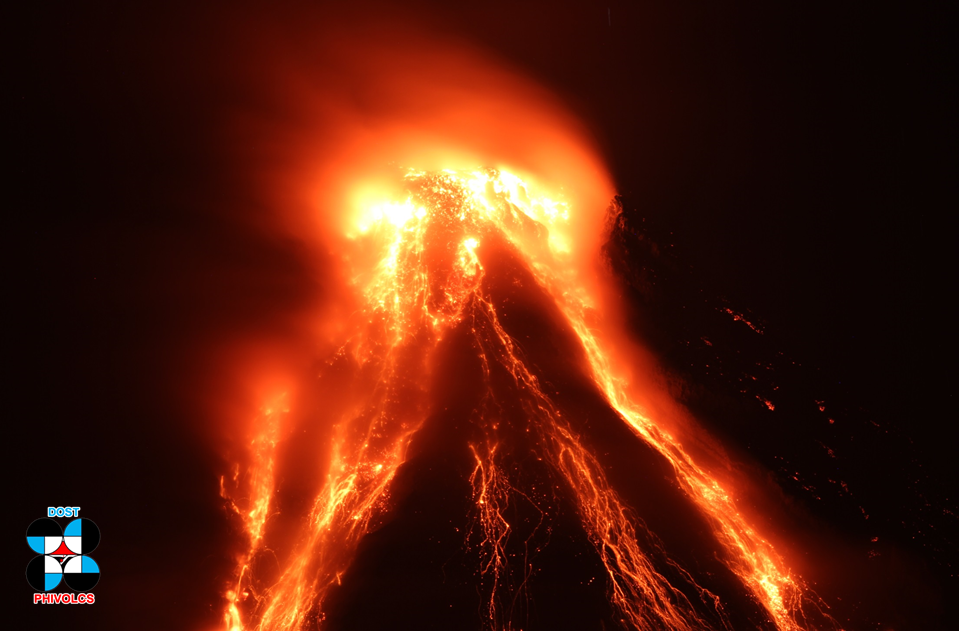Powerful eruption at Mayon volcano, heavy ashfall and zero visibility, Alert Level 4

A powerful eruption took place at Mayon volcano, Philippines around 04:45 UTC on Monday, January 22, 2018 (12:45 local time), producing a column of ash that rose up to 7.6 km (25 000 feet) above sea level. At 05:10 UTC, the Tokyo VAAC reported ash cloud up to 12.5 km (41 000 feet) a.s.l. and corrected it within 30 minutes. Increased activity at the volcano forced authorities to raise the Alert Level from 3 to 4 (hazardous eruption imminent). The scale goes up to 5.
Heavy ashfall was reported in communities around the volcano and as far as Ligao City, some 35 km (21.7 miles) from Legazpi City. Albay Governor said zero visibility has been reported in parts of Guinobatan, Ligao, and Camalig after the major ash eruption, advising everyone to wear their face masks and to stay indoors, especially those in the 3rd district of Albay.
Classes in all public and private schools across the entire province have been suspended.
Volcanologist Ed Laguerta said the eruption lasted for some 8 minutes and generated pyroclastic flows towards Camalig and Guinobatan towns southwest of the volcano.
"The volcano in Albay Province has been exhibiting increased seismic unrest, lava fountaining and summit explosions," PHIVOLCS said 05:00 UTC (13:00 local time), January 22. "In view thereof, DOST-PHIVOLCS is raising the Alert Level of Mayon volcano from Alert 3 (increased tendency to hazardous eruption) to Alert Level 4 (hazardous eruption imminent)."
Because of this, the Danger Zone is extended to 8 km (5 miles) from the summit vent.
The public is strongly advised to be vigilant and desist from entering this danger zone. Civil aviation authorities must also advise pilots from flying close to the volcano's summit as ash from eruptions can be hazardous to aircraft, the agency added.
Mayon's eruption#mayon #volcano #legazpi #albay #bicol #cinemagraph pic.twitter.com/9GsgAupQWu
— Jerry Jethro Calag (@Jethr0) January 22, 2018
PHILIPPINES: Mayon had a towering phreatic eruption around 12 noon today. [Photos sent by a friend based in Albay.] pic.twitter.com/ceHI32lOgo
— Virma Simonette (@virmasimonette) January 22, 2018
Beautiful disaster #mayon magayon pic.twitter.com/EpOzwZYejd
— Francine Ella A. Mangampo (@frncineella) January 22, 2018
Aktibidad ng Mayon sa mga oras @dzbb pic.twitter.com/A28czxOJpn
— Allan Gatus (@allangatus) January 22, 2018
Gov Al Francis C. Bichara passing along the following images from Mount #Mayon in the Philippines: pic.twitter.com/UkWonwrz93
— Mike Adcock (@MikeAdcockWx) January 22, 2018
Cousin staying in Legazpi, Albay sent me this pic, #Mayon #MayonVolcano spewing ash this afternoon pic.twitter.com/EhsjaV7wiu
— Menard Osena (@Menardconnect) January 22, 2018
Just in. Alert level 4 was raised over Mayon Volcano.
This means extension of danger zone to 8 kilometers or more is recommended in the sector where the crater rim is low. The public is advised to wear protective masks and continue to be safe and vigilant.
(Video: @MJEvalarosa) pic.twitter.com/5d4NkhgA6t— Philippine Red Cross (@philredcross) January 22, 2018
JUST IN: Status of Mayon Volcano as PHIVOLCS raised the alarm to Alert Level 4 due to ash fall | via Connie Destura-Calipay #MayonVolcano pic.twitter.com/Ce1FZ6KSOH
— Phil News Agency (@pnagovph) January 22, 2018
#mayon wave of ash pic.twitter.com/rXFxFJSsiI
— Deym Engle (@harlejung30) January 22, 2018
BREAKING: Mayon Volcano spews ashfall as far as ten kilometers, zero visibility up in the 2nd and 3rd districts of Albay. | via Connie Destura pic.twitter.com/UFPjeuEk6V
— Phil News Agency (@pnagovph) January 22, 2018
Scary diba?! #Mayon #Ashfall pic.twitter.com/I2253hN3TY
— Sinbad (@MisterSinBad) January 22, 2018
#Philippines des images de la situation autour du Volcan #Mayon en ce moment par @saleema_refran
pic.twitter.com/eWjHFesXN4— AsieNews (@AsiaNews_FR) January 22, 2018
PHIVOLCS Director Renato Solidum reminded the public not to panic. "The public is reminded to observe the danger zone — not to panic, but in essence just be ready. Prepare either gas masks, handkerchiefs or clothes to prevent inhalation of fine ash," he told CNN Philippines.
He warned of two possible scenarios: continuous lava eruptions, or a more dangerous pyroclastic flow.
As a long-term solution, residents should start settling more than 6 km away from Mayon, so they won't have to evacuate frequently, he said.
On Sunday, January 21, lava fountaining reached a height of about 500 m (1 640 feet) above the crater and ashfall was reported in Oas and Guinobatan, Albay:


Lava fountaining on Mayon volcano – January 21, 2018. Credit: PHIVOLCS


Lava fountaining on Mayon volcano – January 21, 2018. Credit: PHIVOLCS
Geological summary
Beautifully symmetrical Mayon volcano, which rises to 2 462 m (8 077 feet) above the Albay Gulf, is the Philippines' most active volcano. The structurally simple volcano has steep upper slopes averaging 35-40 degrees that are capped by a small summit crater. Historical eruptions at this basaltic-andesitic volcano date back to 1616 and range from strombolian to basaltic plinian, with cyclical activity beginning with basaltic eruptions, followed by longer term andesitic lava flows.
Eruptions occur predominately from the central conduit and have also produced lava flows that travel far down the flanks. Pyroclastic flows and mudflows have commonly swept down many of the approximately 40 ravines that radiate from the summit and have often devastated populated lowland areas.
Mayon's most violent eruption, in 1814, killed more than 1200 people and devastated several towns. (GVP)
Featured image: Mayon volcano, Philippines on January 22, 2018. Credit: Albay Governor Francis C. Bichara

Commenting rules and guidelines
We value the thoughts and opinions of our readers and welcome healthy discussions on our website. In order to maintain a respectful and positive community, we ask that all commenters follow these rules.